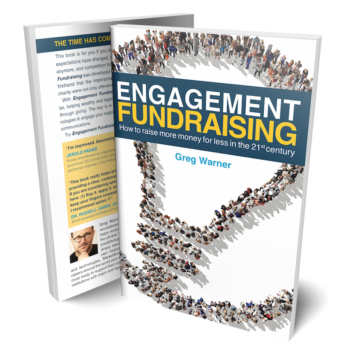We use cookies to ensure that we give you the best experience on our website. By continuing to use this site, you agree to our use of cookies in accordance with our Privacy Policy.
 Login
Login
Your Role
Challenges You Face
results
Learn
Resources
Company
Top 5 reasons why it might be time to kill donor visit quotas!


Quotas… YUCK!
Many major and planned giving professionals are required to secure and carry out a certain number of face-to-face visits each year. This is considered by too many to be an effective measure of their effectiveness in their role. But, unfortunately, quotas lead to inefficiencies that cost the organization inordinate amounts of money.
Here are my top 5 reasons why you should kill visit quotas:
- More often than not, the quota is arbitrary. Leadership rarely knows how many visits are really necessary. In fact, they rarely know what the role of a gift officer really entails. It’s a wild goose chase that ultimately paints an inaccurate picture of the gift officer’s true activity and performance.
- According to the Stanford Graduate School of Business, businesses increase sales by an average of 9% after they remove quota systems.
- They lead many fundraisers to meet with unqualified donors just to hit their quota— ignoring the fact that, for instance, five really great visits with highly-qualified donors will generate more funds than 50 visits with unqualified donors.
- Many gift officers fudge their numbers and game the system to hit the goal.
- Gift officers don’t like quotas!
Do you have more reasons why we should kill quotas? If so, please help me add to this list.
Related Posts:
>>Here’s a job description for a major gift or legacy gift lead outreach associate
>>Why fundraisers shouldn’t be making friends with donors
LIKE THIS BLOG POST? LEAVE YOUR COMMENTS BELOW AND/OR SHARE IT WITH YOUR PEERS!
Get smarter with the SmartIdeas blog
Subscribe to our blog today and get actionable fundraising ideas delivered straight to your inbox!

It leads to unreasonable expectations of the major gift officer by higher ups.
Yes! Agreed! Thanks Joan.
I respectfully disagree. The issues you cite, imho, are a question of professionalism, not goals. I’ve advanced and closed a LOT more gifts in the donors’ living rooms than in my office, especially big gifts.
Thanks,
Jeff Comfort
Thanks Jeff. But I’m confused. We’re talking about quotas, not goals. They are different.
Also, they vary even further when we look at whether gift officers are involved in developing them or not.
So, are you saying you disagree with the 5 reasons I put forth for killing visit quotas? Do you disagree that quotas are often arbitrary at many organizations? Do you disagree with Stanford’s findings? Do you feel quotas never lead to unqualified visits? Do you believe that gift officers never fudge their numbers at any organization/institution? Do you feel that gift officers love quotas?
I’m not sure I understand what you disagree with. Please help us understand.
I 100% agree that goals help motivate people to get out of their chairs and into people’s homes… and that’s exactly where they should be. But quotas are different than goals, especially if they are arbitrary, unrealistic and absent a focus on quality over quantity.
Greg- I know some gift officers don’t like quotas but most high performers somehow manage to regularly exceed them. I won’t quibble with Stanford’s academics and while I often find “truth” in data please allow me to just fall back on 34 years of experience. Long before our industry started using metrics and quotas I learned that top gift officers who focused on making the most visits usually closed the most gifts. Top gift officers don’t bother trying to game the system and make worthless visits just to make a quota. The latter leads to embarrassing meetings with supervisors (why did you spend your time meeting with XXX?) and less time to devote to making fundraising goals. Instead top performers focus on making productive visits with viable prospects. I can think of a number of times where I’ve heard “I/we don’t have any good prospects” where I have researched for prospects for them and provided a list only to go back a month or so later and found few if any had been followed up on.
Let’s set semantics aside… quotas or goals. I see them as guideposts and tools for success not sticks to beat fundraisers.
I found this curious. What metric might be a better option?
In the end, the idea is quality vs. quantity. Here are just a few metrics to consider along with, most importantly, an eye on quality:
– Outreach-to-meeting/visit set ratio (how many contacts via email, telephone or other channel does it take to set a meeting): Optimizing this builds efficiency that trickles down making the rest of the funnel much more efficient
– # of meetings/visits set per week/month/quarter/year
– # of meetings/visits completed per week/month/quarter/year
– # of meetings/visits with donors that were rated as highly qualified (as determined after the meeting/visit)
– Qualification level of each donor (Qualified, somewhat qualified, not qualified, unsure)
– Where each donor prospect resides in the consideration process (awaiting decision, proposal review requiring more discussion, cultivation/considering a gift, cultivation/might consider a gift, cultivation/might someday consider a gift, donor discovery and qualification)
– Average days to close a gift
– # of referrals from major donors to other major donors gained each month/quarter/year
– Referral-to-meeting/visit rate
– Referral-to-close rate
Etc……
I love quotas! But in my experience it is often some donors who aren’t interested in seeing US many times per year. They want responsivness, they want results, but not to carve out time on a more frequent basis than they see some of their own family members! Save our retired stakeholders, many of our donors are as busy as we are, maybe more so.
Right on Simone!
What you describe here seems to be a leadership problem, rather than a quota problem. If you’re setting metrics for your team that create a disincentive to pursuing quality donor relationships and achieving revenue targets then you are probably the problem – not because of the metrics you’ve chosen but because of the way you’ve chosen to use them. As leaders we need to set metrics for our teams that, when taken together, show the full complement of gift officer activities. Visits should be just one metric out of several, along with donor contacts, meetings, asks made, gifts received – all of those are metrics we should track together. If I have a GO that is contacting enough donors, making enough asks, and raising enough money but is behind in donor visits? I’ll live with that. Same goes for being behind in contacts if they’re visiting, asking, and raising – I am still fine with it. The problem comes when you prioritize one metric (other than revenue) over the others.
So true. A leadership problem, not a metrics problem! Good thinking Jennifer.
There are many points that are being made in the comments, and the truths they contain are not mutually exclusive.
Simone is correct, not all donors want to be in touch with us as frequently as the quotas might demand. If our goal is to be a donor-centered organization, then that information should drive our contacts. That speaks to the quality that is a focal point of Greg’s comments.
Jeff speaks of talented, professional gift officers who likely benefited from a mentor earlier in their career. Too few are fortunate to learn from a gift officer such as Jeff. This speaks to a critical deficiency in the training of gift officers – it is largely absent.
Much of my career has focused on the meaning of statistics and analytics as applied to fundraising. The sad truth is that only 1 in 5 gift officers succeed, and I blame that on training and professional development. Too many gift officers do not know how to successfully build relationships with donors and prospects. Those who do succeed often learn on their own.
As a result, gift officers are forced to recycle every 18-24 months to maintain a career path prior to those deficiencies being discovered. It is not good for the profession, and the organizations they represent suffer as well.
From my perspective, quotas are only relevant if you have the professional staff that Jeff references. Absent that, you will not have quality, and without that, quantity is irrelevant. There are resources available for professional training, and nonprofits and higher education institutions should be willing to invest in it. After that occurs, those trained professionals will understand the need for metrics.
Thanks this wise contribution to the thread Lawrence.